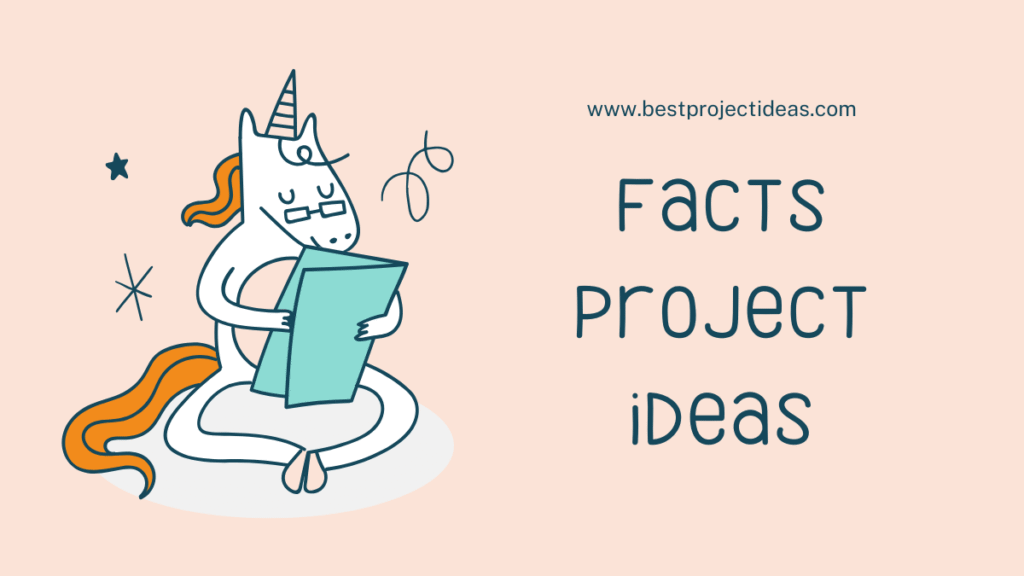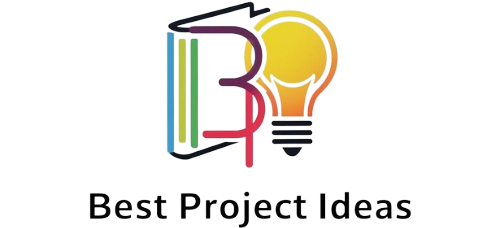
Looking for engaging, easy-to-do school projects that teach interesting facts? This article gives a clear explanation of what facts project ideas are, tips to pick and present them, safety pointers, and 150 ready-to-use facts project ideas grouped by category.
I’ve written these in simple language so you can start quickly. Let’s go!
What is facts project ideas?
A facts project idea is a small research or hands-on activity built around a true, checkable fact.
The goal is to explain, show, or prove that fact using experiments, models, posters, charts, simple demonstrations, or short reports.
These projects teach knowledge plus how to present evidence and explain why the fact is true.
Why do facts projects matter?
- They help students learn to check facts and think critically.
- They combine learning and doing — helping memory and understanding.
- They’re great for science fairs, class assignments, and quick presentations.
How to choose a good facts project
- Pick a fact that interests you.
- Make sure it’s measurable or demonstrable (can be shown, tested, or explained).
- Check materials are safe and available.
- Keep the scope small — finish in time.
- Think about one clear conclusion you’ll show.
Common materials & tools (easy items)
Paper, markers, cardboard, glue, basic kitchen items (vinegar, baking soda, salt, sugar), thermometer, stopwatch, ruler, magnifying glass, simple electronics (battery, LED), plants, soil samples.
Simple step-by-step plan for any facts project
- Choose your fact and write a one-sentence question.
- Do quick background reading (few lines).
- Design a simple test or display.
- Collect results (observations, photos, measurements).
- Make a poster or short report.
- Present: state the fact, show evidence, give a short explanation.
MUST READ: 150 Multiple Choice Project Ideas — Easy, Smart & Classroom-Ready Options
Safety & presentation tips
- Always wear safety gear if needed.
- Avoid hazardous chemicals.
- Label your display clearly (title, question, method, results, conclusion).
- Practice presenting in 2–3 minutes.
150 Facts Project Ideas 2025-26
(Arranged in 10 categories — 15 ideas each. Each idea includes the fact to explore and a short note on how to show it.)
A. Basic Science Facts
- Water expands when it freezes — show water in bottle before & after freezing.
- Hot air rises — demonstrate with a simple heat balloon or convection candle.
- Salt raises boiling point slightly — compare boiling times for plain vs. salty water.
- Vinegar + baking soda produces CO₂ — inflate balloon from reaction.
- Objects of different mass fall at same rate (in absence of air) — drop small paired items and explain air resistance.
- Paper burns, but ash shows original carbon — careful small burn demo and collect ash (supervised).
- Surface tension holds small objects — float a paperclip on water using careful placement.
- Plants release oxygen during photosynthesis — trap bubbles from a water plant under light.
- Sound needs a medium to travel — show sound in air vs. near-vacuum sealed jar demo.
- Light travels in straight lines — laser through pinholes to show beam path.
- Air has weight — measure weight of inflated vs. deflated balloon.
- Magnetism affects only certain metals — test various household items with a magnet.
- Different substances have different densities — make a density column (oil, water, syrup).
- Temperature affects solubility — dissolve sugar in hot vs. cold water.
- Friction produces heat — rub two objects and measure temperature rise.
B. Earth & Environment Facts
- Soil types affect water retention — compare sand, clay, and loam.
- Trees reduce local temperature (shade & evapotranspiration) — measure temp under tree vs. open spot.
- Acid rain affects limestone — drip vinegar on chalk to show reaction.
- Compost improves soil — compare plant growth in compost vs. plain soil.
- Ozone vs. good/bad ozone facts — poster explaining layers and effects.
- Erosion shapes land — small stream table to show sediment movement.
- Wetlands filter water — model filter using sand & plants.
- CO₂ levels rise during the day indoors — measure with a sensor (or explain with data).
- Recycling reduces raw material use — create a visual comparison chart.
- Melting glaciers raise sea level — model melting ice in a tray and measure water rise.
- Solar energy varies by angle — measure solar panel output at different tilt angles.
- Microplastics are found in water — microscope show micro particles in samples.
- Urban heat island effect — measure temps in city vs. rural areas (data poster).
- pH affects aquatic life — test pH of samples and show effects on simple organisms (info-based).
- Noise pollution harms wildlife — case study poster with local examples.
C. Biology & Health Facts
- Handwashing reduces germs — glow-germ demo or before/after count (illustrative).
- Vaccines train immune memory — infographic showing immune response.
- Plants need macronutrients (NPK) — grow seedlings with/without fertilizer.
- Exercise raises heart rate — measure pulse before/after simple exercise.
- Sleep affects concentration — short self-study test after different sleep durations.
- Sugar affects yeast respiration — show CO₂ from yeast + sugar vs. control.
- Bacteria grow faster at certain temps — bacterial culture on agar (school-safe strains & supervision).
- Vision depends on light & focus — pinhole camera demo and focusing lens experiment.
- Taste can be influenced by smell — blindfold taste test showing smell impact.
- DNA can be extracted from fruit — simple strawberry DNA extraction.
- Posture affects breathing efficiency — measure breaths per minute sitting vs. slouched.
- Antibiotics don’t kill viruses — chart comparing antibiotic action vs. antivirals.
- Body loses water through respiration — measure weight of wet vs. dry clothing after breathing (illustrative).
- Blood clotting basics — poster or safe simulation (no live blood).
- Microbiome affects digestion — explain with simple fermented food examples.
D. Physics & Chemistry Facts
- Energy can’t be created or destroyed — simple pendulum and energy transfer demo.
- pH scale shows acidity/basicity — color chart using red cabbage indicator.
- Catalysts speed reactions — demonstrate with enzyme-like actions (yeast or manganese dioxide).
- Chemical reactions can be endo/exothermic — mix substances that heat or cool (hand warmers vs. ice packs analogies).
- Electric current needs a closed circuit — build basic circuit to light an LED.
- Refraction bends light — straw-in-glass appears bent.
- Brownian motion proves molecular movement — watch pollen in water under microscope.
- Pressure decreases with altitude — balloon inflation at different heights (model).
- Alloys change properties — compare copper and bronze conductivity/appearance.
- Electromagnets form with current — coil + battery magnet demo.
- Capillary action moves liquids — colored water up paper towel or plant stem.
- Crystal growth depends on saturation — grow salt or sugar crystals.
- Radioactivity (basic fact) — safe poster explaining natural background radiation (no experiments).
- Phase changes absorb/release energy — show melting/freezing and temperature plateau on thermometer.
- Solubility vs. miscibility — oil and water vs. alcohol and water mixing.
E. Math & Data Facts
- Golden ratio appears in nature — photo examples and simple measurement.
- Fibonacci sequence in plants — count petals or seed spirals in sunflower.
- Probability basics with dice — experimental vs. theoretical probability.
- Pi is constant — measure many circular objects and calculate circumference/diameter.
- Graph types tell different stories — collect small data and show bar/line/pie examples.
- Prime numbers distribution — poster showing primes up to 1000 and patterns.
- Scale models keep proportions — build a scale model and explain ratio.
- Mean, median, mode in class data — survey classmates and compute statistics.
- Patterns in weather data — chart temperature across a month and analyze.
- Convert units and why — real-world examples of wrong unit conversions causing issues.
- Angles add up in polygons — measure and prove sum of interior angles.
- Pythagoras theorem visually — square-on-sides proof with paper cutouts.
- Symmetry in art and nature — mirror-folded plant/leaf impressions.
- Exponential growth vs. linear — compare modeled graphs for populations.
- Error and measurement accuracy — show repeated measurements and variation.
F. Technology & Engineering Facts
- Simple machines multiply force — lever demo lifting weight.
- Bridges distribute load differently — model arch vs. beam bridge stress test.
- Battery life depends on load — run LED vs. motor and compare time.
- Insulation slows heat flow — compare temperature change in cups wrapped with different materials.
- Robots follow programs step-by-step — make a paper “robot” with coded instructions.
- Wi-Fi is radio waves — poster explaining radio spectrum and interference.
- 3D printing builds objects layer by layer — show printed sample and layer close-up.
- Algorithm efficiency matters — timed sorting of small lists manually vs. optimized method.
- Sensors measure environment — demo with light sensor or simple homemade sensor.
- Wind turbines convert wind to electricity — small turbine and multimeter measurement.
- Hydraulic systems use fluid pressure — simple syringe-based model lifting a load.
- Compression vs. tension in structures — test small beams under load.
- Encryption hides messages — simple cipher demo and decryption.
- Heat sinks help cool electronics — compare temperature of a heated device with/without sink.
- GPS uses satellites for location — poster explaining trilateration with simple drawings.
G. History, Culture & Social Facts
- Ancient civilizations used irrigation — model showing water channels and crop yield.
- Printing press spread information — timeline poster with images (no links).
- Languages borrow words — infographic showing loanwords in your language.
- Traditional medicines vary by region — sample case studies (no medical claims).
- Trade routes changed cultures — map showing exchange of goods & ideas.
- Currency design reflects history — poster analyzing symbols on coins/bills.
- Famous inventions changed daily life — compare “before & after” scenarios for 3 inventions.
- Festivals have symbolic meanings — display festival objects and explain facts.
- Voting systems influence results — compare first-past-the-post vs. ranked voting with example.
- Historical timelines are created from evidence — show layers of evidence for a local event.
- Architecture reflects technology — compare two buildings from different eras.
- Food migration shows cultural link — trace origin of a local dish on a map.
- Clothing adapted to climate — display fabric samples and reasoning.
- Symbols and flags have meanings — decode a flag’s elements in a poster.
- Population shifts affect cities — chart census data long-term (visual).
H. Geography & Earth Science Facts
- Mountains form by plate collision — plate model and diagram.
- Volcanoes release gases & lava — safe model using baking soda and vinegar for eruption shape.
- Rivers create deltas — stream table to show deposition.
- Continents fit together (continental drift) — jig-saw map fit demonstration.
- Oceans have currents that affect climate — globe + arrows poster showing major currents.
- Weather fronts cause storms — simple warm vs. cold air model with layered liquids.
- Islands have unique species — poster case study of an island ecosystem.
- Longitude affects time zones — make a local time zone clock comparison.
- Soil layers (horizons) show history — dig a small profile and label horizons.
- Deserts form from rain shadow — map and model showing mountain blocking rain.
- Glacial movement shapes valleys — model sliding block with sediment.
- Coral reefs need clear shallow water — aquarium model showing light penetration.
- Earthquakes happen along faults — fault box model to show movement.
- Human activities change landscapes — photo comparison poster (local examples).
- Mangroves protect coasts — model showing roots reducing wave energy.
I. Art, Language & Culture Facts
- Primary colors mix to create others — color mixing with paints demonstration.
- Different scripts evolved differently — timeline poster showing script changes.
- Perspective creates depth in drawing — draw same scene with/without perspective.
- Music scales produce harmony — simple instrument demo of consonant vs. dissonant intervals.
- Local proverbs reflect values — collect and explain a few proverbs and their facts.
- Fabrics dyed naturally vs. synthetically — compare colorfastness tests.
- Traditional dances tell stories — short video or poster analyzing movements (if allowed).
- Architecture styles have patterns — identify and display patterns from local buildings.
- Typography affects readability — show same text in many fonts and read speed test.
- Cultural symbols adapt over time — trace symbol evolution with images.
- Story structure has common elements — map a local folktale to narrative arc.
- Colors affect mood — small survey on reactions to different colors.
- Handwriting reveals style differences — collect samples and compare letter shapes.
- Language families link countries — tree diagram showing relationships.
- Public art reflects history — photo-case study of a local mural or statue.
J. Fun, Trivia & Miscellaneous Facts
- People blink ~15–20 times/min — time and count experiment (observe multiple people).
- Yawning can be contagious — quick group test to see if yawns spread.
- The human nose can detect thousands of smells — smell test with safe items and results chart.
- Some coins float in certain solutions — density trick with saltwater glass.
- Dogs’ sense of smell is much stronger than humans’ — poster with comparative facts and simple sniff test game.
- Old books have a distinct smell due to chemicals — explain chemistry behind smell.
- Paper can be made from recycled paper — hand-made paper workshop.
- Shadow length changes during the day — sundial project showing sun’s path.
- A single lightning bolt is hotter than the sun’s surface — poster with comparative numbers (no experiments).
- Some seeds can survive long dormancy — germinate old seeds vs. fresh seeds (if available).
- Glass is an amorphous solid — explain molecule arrangement with models.
- Cats purr at specific frequencies — investigate frequency ranges and calming claims (poster).
- There are more trees on Earth than stars in the Milky Way (claim to explore fact-checking) — research & data-check project.
- Paper planes show aerodynamics basics — test different designs and record distances.
- Human fingerprints are unique — take safe ink impressions and compare patterns.
MUST READ: Moon Phases Project Ideas for Students: 60 Powerful & Creative Activities
Quick presentation checklist
- Title + one-line fact statement.
- Materials list (3–6 items).
- Short method (3 steps).
- Result snapshot + short conclusion (1–2 lines).
- Safety notes if needed.
Outro
Pick one fact that excites you and try it this week. Start small, show one clear result, and explain the why.
If you want, tell me which category you like and I’ll give a ready-made 1-page project sheet (materials, steps, presentation text) for any single idea from the 150 above. Which one do you want to build first?

